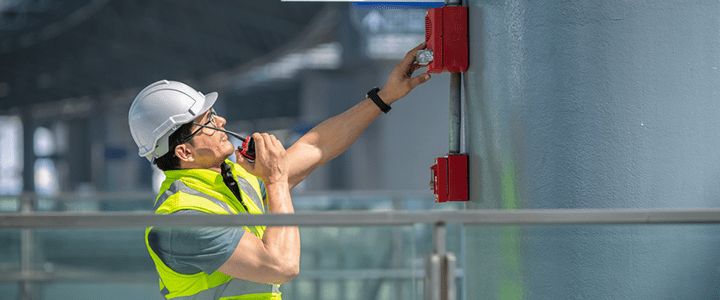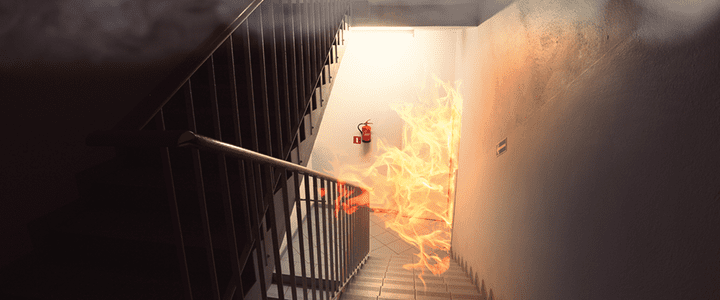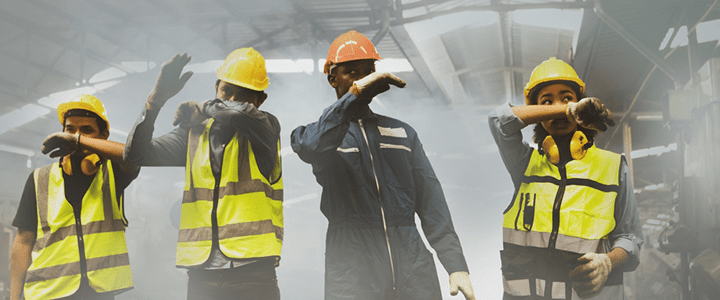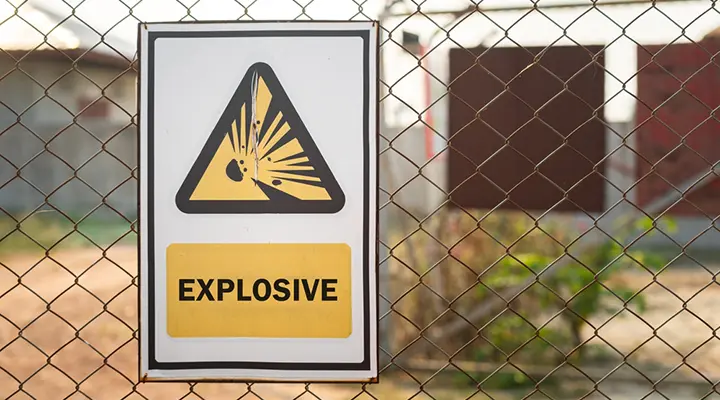A Fire Marshal, also referred to as a Fire Warden, plays a key role in fire prevention and the safe evacuation of a building in an emergency.
If your workplace ever faces a fire emergency, having designated fire marshals appropriately trained could be key to a good outcome.
A Fire Marshal is a person, usually a member of staff, nominated to implement fire safety measures and ensure the safety of employees and visitors if a fire breaks out.
A Fire Marshal may also carry out risk assessments and ensure that fire prevention best practice is followed in the workplace. However, to be effective, a Fire Marshal MUST have management support so that they have the time and authority to carry out their duties.
What are the 6 fire marshal responsibilities?
The Regulatory Reform (Fire Safety) Order 2005 states the responsible person must appoint a competent person to implement fire safety measures. This person is usually designated as the Fire Marshal.
The Fire Marshal has a responsibility to:
- Assess fire risks
- Identify and report fire hazards
- Take action if a fire breaks out
- Administer first aid
- Fight fire where necessary and ONLY if safe to do so
- Enable a safe, calm and efficient evacuation
What are the routine duties of the Fire Marshal?

The actual tasks and checks will differ from organisation to organisation. For example, a company employing a handful of staff doing office work will have very different needs to a large organisation that has many visitors or a factory that uses flammable materials or chemicals.
The routine duties of the Fire Marshal focus on fire prevention. They will:
- Ensure exit doors are unlocked and not obstructed.
- Check all escape routes are free from obstruction and available at all times.
- Ensure that flammable or hazardous goods, office supplies and waste materials are stored and controlled correctly.
- Check fire safety signs are visible and not obstructed.
- Make sure that fire extinguishers are in the correct place, serviced and stored correctly.
- Ensure electrical equipment/sockets/cables are maintained and comply with fire safety regulations.
- Conduct periodic testing of emergency lighting.
- Organise routine fire alarm tests, to ensure that the fire detection and fire alarm system is working.
- Check smoking areas are cleaned and smoking receptacles are emptied.
- Organise fire safety inductions for new staff and refresher training for existing employees.
- Be an advocate for fire safety.
What is the Fire Marshal’s role in an emergency?

When a fire breaks out, people often panic and forget any fire training they have had. The evacuation can easily become chaotic, increasing the risk of injury or a fatal incident. Therefore, at all times the Fire Marshal must remain calm and act with confidence.
If a fire does start in a building, typically a Fire Marshal will:
- Raise the alarm (if not done so already) and notifying the emergency services
- Assist with evacuations where required. Such as, visitors, children, disabled or vulnerable people might not be able to evacuate safely by themselves.
- Sweep the building to ensure that everyone has been evacuated.
- Prevent the fire and smoke from spreading, by closing the doors or windows. This should only be done when it is safe to do so.
- Fight the fire. Only to be done when it is safe to do so.
- Attend assembly points and take roll calls. To ensure that everyone has evacuated the building. No-one should re-enter the building until the emergency services say it is safe.
- Coordinate with other fire marshals to ensure that the evacuation was successful.
- Communicate with the emergency services, information on the location and type of the fire. Also, if there are any injuries.
How many Fire Marshals do I need?

The number of Fire Marshals a business needs will depend on the size of the building and the risk that the building poses.
You should also take into account these three things:
- Number of floors – There must be at least one Fire Marshal for each floor of the building.
- Holidays and sickness - Additional Fire Marshals are needed to cover absences like sickness or holidays.
- Shifts that need to be covered - Additional Fire Marshals are needed to cover each shift.
LOW fire risk workplaces
These are workplaces with some or all of the following are true:
- Traditional construction and well maintained premises.
- No high risk groups on the premises, like elderly or disabled people.
- Few or no highly flammable materials on the premises.
- Few or no heat sources that could start a fire.
- Appropriate fire safety measures, such as fire doors, signs and correctly stored firefighting equipment.
- Clear and safe escape routes.
Typical workplaces in this category are small shops and offices.
A low risk workplace requires 1 Fire Marshal for up to 50 people and 2 Fire Marshals for between 50 and 100 people.
MEDIUM/NORMAL fire risk workplaces
These are workplaces where some or all of the following are true:
- High risk groups present, like elderly or disabled people.
- Some highly flammable materials present.
- Some heat sources that could ignite a fire.
- Measures in place to confine or slow the spread of a fire.
- Well maintained and appropriate fire safety measures.
This covers most workplaces like large offices and shops, factories, warehouses and engineering plants.
A normal risk workplace requires 1 Fire Marshal for up to 20 people and 2 Fire Marshals for between 20 and 75 people.
HIGH fire risk workplaces
These are workplaces where some or all of the following are true:
- A construction that would allow a fire to spread quickly.
- Many high risk groups present.
- High quantities of highly flammable materials on the premises.
- Multiple heat sources that could ignite a fire.
- Complex layout that would slow down the evacuation of people.
Typical workplaces that would be in this category are in two groups: 1) Workplaces with a high risk of a fire occurring, like restaurants or catering kitchens, industrial premises which house highly flammable liquids or gases. 2) Workplaces where evacuation is difficult, like care homes, hospitals, nurseries and schools.
A high risk workplace requires 1 Fire Marshal for up to 15 people and 2 Fire Marshals for between 15 and 50 people.
As you can see the number of fire marshals will vary depending on a range of factors as mentioned in this article. If you have any doubts on the number of fire marshals required in your workplace, we recommend you contact your local fire service for advice.
Need Fire Marshal training?
We offer the following RoSPA-assured and CPD-certified online Fire Marshal training courses.
Online Fire Marshal / Warden Training
Want some advice on training?
Finally, if you need help or advice on any of our courses, please contact us. Our team are always happy to help. You can get in contact at 0333 577 5016 or sales@i2comply.com.




